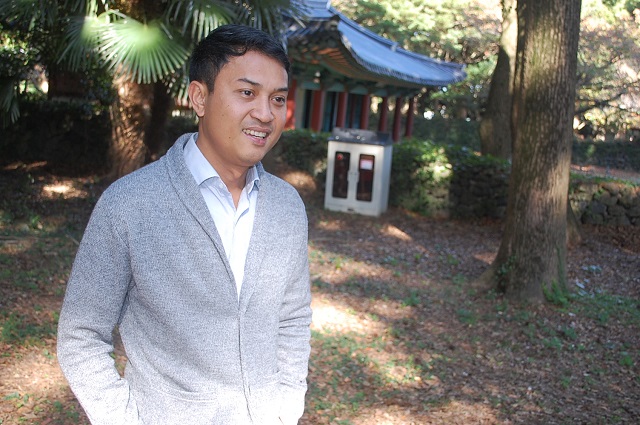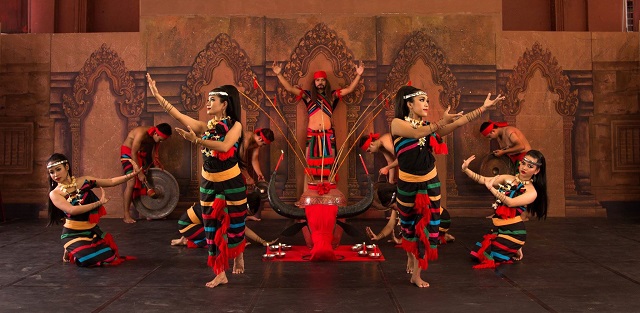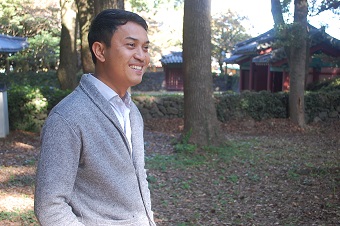| |
 |
|
| ▲ Photo by Darren Southcott |
When Pol Pot’s Khmer Rouge killed up to 2 million Cambodians between 1975 and 1979, the Communist regime sought to return its subjects to an imagined state of nature without history, culture or tradition.
After an estimated 90 percent of Cambodia’s artists, musicians, dancers and intellectuals were killed, traditional Khmer culture was almost lost.
Founder of Cambodian Living Arts (CLA), Arn Chorn-Pond said that art’s threat to the regime was in allowing Cambodians to express “who they were as human beings.”
In building its dystopian Eden, the Khmer Rouge sought to remove people’s ability to not only subvert power, but also to transmit personal identity, independence and strength.
“No money, no religion, no family. The idea was to bring all people to serve the organization,” says CLA executive director Phloeun Prim as we discuss his work during a recent visit to Jeju.
To escape the genocide as a baby, Prim’s mother carried him through the jungle, and eventually to Canada. After graduating business school there, Prim then returned to the country of his birth.
With his business background and a love for the arts, Prim saw that the post-genocide society needed much more than an improved GDP.
Despite the country’s recent economic growth, most overseas development aid (ODA) has a narrow economic focus, which is unsurprising as over 2.6 million Cambodians live on less than $1.20 per day.
This means that the Ministry of Culture and Fine Arts, poorly funded itself, relies on the support of local NGOs such as CLA to fund grassroots projects.
| |
 |
|
| ▲ Photo courtesy Cambodian Living Arts |
The CLA now supports culture masters in music, dance, and puppetry to bequeath their skills to Cambodian youth, work that Prim says is crucial in helping the society overcome transgenerational trauma.
“I like to use the word ‘resilience.’ Arts and culture help people to find that resiliency,” he says as we walk in the wooded grounds of Samseonghyeol, Jeju City, the very roots of Jeju culture.
I ask Prim how cultural healing differs from more legalistic peace and reconciliation efforts.
“Let’s not hide, let’s open up. I think that is where arts and culture can help express the horror, the trauma, in an inclusive way,” he said.
Prim says the power of culture is clear in the speed with which people returned to their heritage once the threat was gone.
“Culture and art are in the blood of Cambodians. After the atrocity, people said that art is fundamental to their identity, so the first process of re-engaging tradition is really important for any society.”
“It is not just the past, it is our roots... The day you are born, you are born with music in ritual from your birth to your wedding and your funeral. It is that expressive way that is deep rooted in us. “
Etymologically derived from the Latin ‘colere,’ meaning to cultivate, tend and guard, roots are central to ‘culture.’ The word later acquired the connotations of caring and fostering in the 19th century.
| |
 |
|
| ▲ Photo by Darren Southcott |
It is this rootedness in place that the Khmer Rouge sought to rupture, showing the sufficient “intent to destroy, in whole or in part, a national, ethnical, racial or religious group” as defined by the Genocide Convention (1948).
Jeju people experienced similar trauma during the Jeju Massacre (Jeju 4.3) and Prim spoke on the subject at the Jeju 4.3 Peace Forum Roundtable on Oct 30 which explored culture and healing in post-conflict societies.
To ensure such traditions are not lost to later generations, the leaders supported by CLA, often genocide survivors themselves, teach traditional arts to youths who later graduate to become leaders themselves.
Rather than seeking a return to an imagined pure Khmer culture, the CLA fully encourages its young artists to engage with the modern world — hence the “living” in Cambodian Living Arts — even if that is resisted by traditionalists.
“Those traditional dancers know the tradition well, but now are expressing new forms, attracting new audiences and generating new interest.”
Prim’s entrepreneurial spirit — he runs CLA “like a business” — has attracted attention worldwide, and he was chosen as one of the Asia Society’s Asia 21 Young Leaders in 2013.
The apogee of his work so far was as “the architect” of the Season of Cambodia in New York when 125 Cambodian artists performed alongside over 30 New York institutions in 2013.
“It was not a festival for me. It was to help change the narrative of a nation. We want culture to become the international signature of the country, not the Killing Fields.”
That narrative change will take time, time that is not always given by international donors looking for quick-fix ODA projects.
“If you want to make a change you have to make a change in the generations. We might not see the result ourselves, but the impact will be much deeper and more sustainable.”
“Transmission is not about art forms, it is about human beings. When a master teaches music to his student, he is not teaching a song, he is teaching what it is to be human, the character. It is this strength that he is transferring to the next generation.”
The arts and culture ecosystem is only as strong, however, as its weakest link, and Prim headhunts young culture leaders — visionary administrators — who are “just as important as investing in creativity and artistic development.”
“[I]n New York, I felt lonely. Lonely because I wanted to have peers, Cambodians, with me there. I realised that to be able to have those peers, I need to make the investment in young leaders over the next five or 10 years.”
“Look at the Arab Spring. People thought that just by removing the dictator the movement of change would sustain... We needed to accompany the young people through that process. We left them.”
As the last three words are left to hang in the air, the passion that drives his work is clear on Prim’s face. |






















